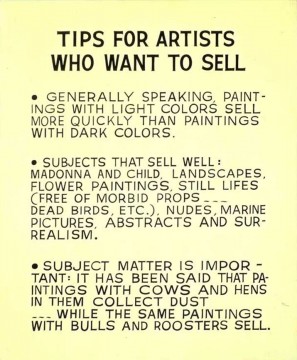Every so often, there comes along a retrospective exhibition or mid-career survey that puts to rest whatever doubts I may have had as to where a particular artist sits in my personal pantheon of favorite artists. It is on these rare occasions when, afforded the luxury of considering his or her work en masse, an artist that I may have been ambivalent about finally clicks into place in my mind, and I gain a newfound clarity as to the significance of that artist’s oeuvre to me. Two recent exhibitions come to mind that have affected me in this way, almost single-handedly shoring up my interest in the artist: the Tate Modern’s 2005 exhibition Joseph Beuys: Actions, Vitrines, Environments and the Neuberger Museum’s Tania Bruguera: On the Political Imaginary in 2010.
John Baldessari: Pure Beauty, currently on view at the Metropolitan Museum of Art, has been added to this list. Pure Beauty marks the first major survey of Baldessari’s work in the United States in over twenty years, and offers the chance to see more than 140 works by the pioneering conceptual artist, spanning from 1962 to 2010. And while it is really the critical mass of works in the show that allowed me to appreciate Baldessari on a new level, I will share here my thoughts on a couple of works that helped to finally put Baldessari over the top in my mind.
The first work is A Painting That Is Its Own Documentation (1966-1968), which opens the exhibition. Baldessari’s text painting consists of a set of canvases detailing the work’s own existence and exhibition history since its conception in 1966. The first canvas records the date, time and location that Baldessari conceived of the work, and documents its realization and initial exhibition. As the work’s instructions (which are also included on the initial canvas) dictate, additional panels are added to accommodate the ever-growing exhibition history of the work, with the most recent canvas marking the current show at the Metropolitan Museum of Art and the dates of the exhibition. Endlessly expanding, A Painting That Is Its Own Documentation complicates traditional notions of the art object and process, and succinctly introduces visitors to Baldessari’s deadpan and rigorous conceptualism.

John Baldessari, "Tips for Artists Who Want To Sell," 1966-68. Acrylic on canvas, 68 x 56 1/2 inches. (c) John Baldessari. Courtesy Marian Goodman Gallery, New York.
Baldessari’s Clement Greenberg (1966–68) is another early example of the artist’s interest in questioning the status of art and art making. Clement Greenberg is a text painting consisting of a quotation from the influential art critic Clement Greenberg, whose brand of formalism defined and in many ways prescribed American Modernism after World War II. For Clement Greenberg, Baldessari enlisted a professional sign painter to apply the text to the canvas, detaching himself from the creative process in a manner that challenges the traditional role of the artist and owes a debt to Marcel Duchamp, among others. The text on the canvas reads as follows:
ESTHETIC JUDGMENTS ARE GIVEN AND CONTAINED IN THE IMMEDIATE EXPERIENCE OF ART. THEY COINCIDE WITH IT; THEY ARE NOT ARRIVED AT AFTERWARDS THROUGH REFLECTION OR THOUGHT; ESTHETIC JUDGEMENTS ARE ALSO INVOLUNTARY; YOU CAN NO MORE CHOOSE WHETHER OR NOT TO LIKE A WORK OF ART THAN YOU CAN CHOOSE TO HAVE SUGAR TASTE SWEET OR LEMONS SOUR. (WHETHER OR NOT ESTHETIC JUDGEMENTS ARE HONESTLY REPORTED IS ANOTHER MATTER)
With great economy, Baldessari both establishes and undermines Greenbergian formalism and the inherited legacy of mid-century Modernism within the compact space of his painting. As we read Baldessari’s painting and reflect upon the meaning of its words, the very immediacy and primacy of experience espoused by Greenberg is undermined by our own act of looking at it. By using as the basis for his painting a fragment of text that in effect proscribes the presence of words in art, Baldessari produces a work that wryly exposes the arbitrariness of such declarative determinations of artistic value and also eludes their restrictions. And while Clement Greenberg exemplifies conceptual art’s reconsideration of conventional notions of the art object and the role of the artist, it is also an important early iteration of Baldessari’s career-long investigation of the interrelationship between words and images, and the social, ideological and popular cultural contexts that determine their meanings and frame our understanding of them.
Given these interests, it is perhaps not surprising that before long Baldessari, being born and raised in Californian and based in Los Angeles, began incorporating Hollywood film stills and other cinematic themes and imagery into his work—Hollywood being a hotbed of manufactured drama in a world of images. Baldessari’s Pelicans Staring at Woman with Nose Bleeding (1984), for example, brings together two found photographs to produce a mysterious, perhaps ominous narrative of Hitchockian proportion. “As soon as you put together two things you have a story,” Baldessari once remarked. Indeed, by simply juxtaposing two images that are otherwise a study in contrasts—color versus black and white, human versus animal, active versus motionless—Baldessari reveals the power of formal organization on meaning production. The simple act of placing the picture of the woman to the right of the other photograph suddenly invests her sideways glance with meaning—what would otherwise be an equivocal gaze now seems directed at the pelicans, which in turn appear to return her stare. Our desire to attribute meaning to this seemingly incongruous juxtaposition of images cascades across the two photographs, as one can’t help but wonder if the agitated pelicans are somehow responsible for her bloodied nose. The ease and speed with which connections are drawn between the paired photographs functions as a simple reminder that an image’s meaning is contingent upon and manufactured through its context.
The prospect raised by Pelicans Staring at Woman with Nose Bleeding that context is the very basis of meaning production is the tie that binds much of Baldessari’s work, including A Painting That Is Its Own Documentation, which reveals context as the structural logic of artwork itself, and Clement Greenberg, which alludes to the prescriptive and restrictive nature of aesthetic criteria and definitions that often frame the reception of art. The power of context to shape the meaning of words and images has been the subject of art for some time now, but it is the way in which Baldessari’s critical reflections continue to challenge and delight that makes his work exceptional, and this exhibition a must-see.
John Baldessari: Pure Beauty, organized by the Los Angeles County Museum of Art in association with Tate Modern, London, is on view at the Metropolitan Museum of Art until January 9, 2011.




